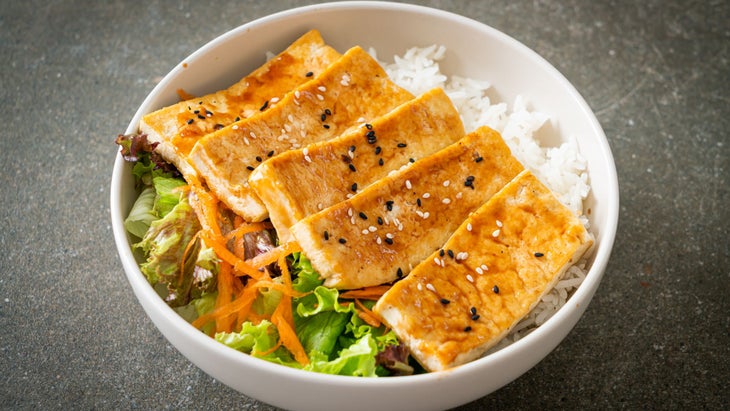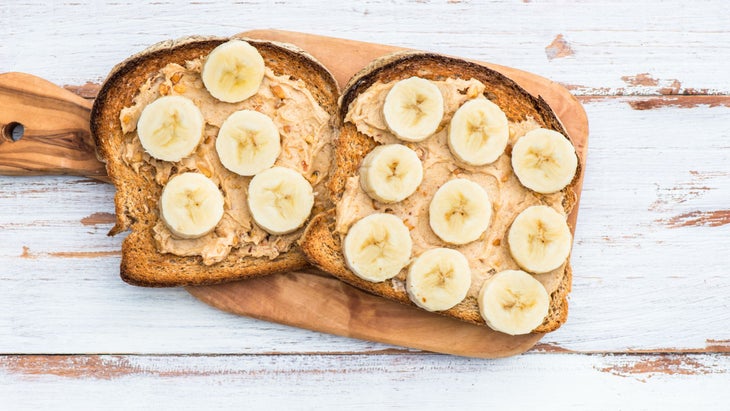Heading out the door? Read this article on the new Outside+ app available now on iOS devices for members!
<a href="https://outsideapp.onelink.me/wOhi/6wh1kbvw" class="o-content-cta-link" data-analytics-event="click" data-analytics-data="{"name":"Element Clicked","props":{"destination_url":"https://outsideapp.onelink.me/wOhi/6wh1kbvw","domain":"<>”,”name”:”in-content-cta”,”type”:”link”}}”>Download the app.
Professional trail and ultrarunners, they’re just like us! Well, at least when it comes to learning through some nutrition mishaps. Many pros struggle or have struggled with their nutrition like us mere mortals. Pros learn through trial and error like the rest of us.
We asked professional runners John Kelly, Amelia Boone, Leah Yingling, and Michael Wardian to share some of their biggest fueling mistakes, how they corrected them, and what they learned from their experiences so you can avoid the same errors during your next big race.
Pre-Race Disaster
Wardian and Boone are not strangers to competition and have encountered their fair share of fueling mistakes over the years, with one of their biggest challenges being dialing in their nutrition the days leading up to the race.
Wardian has completed more than 300 marathons and ultramarathons in his career and has set 25 fastest known times on routes across the world.
“My biggest mistake was eating a burrito the night before the San Francisco Marathon,” he says. “This made for a long, sleepless night and a terrible start to the race. Despite many bathroom stops, I did rally and ended up winning the race. I have now learned that I need to have a game plan for my day-before-a-race meals and be mindful to keep things more simple and save the flavorful choices for after the race.”
Boone, an ultrarunner, 4x obstacle course racing world champion and 3x winner of the World’s Toughest Mudder says she discovered the beauty and simplicity of the pre-race Pop-Tart after learning a tough lesson about what not to eat before a race. Following good-intentioned but slightly misinformed advice, she ate oatmeal for a pre-race meal and ended up in a bush a few miles in. That was her last bowl of pre-race oatmeal ever. Now, she actively promotes Pop-Tarts as an easy way to get in convenient carbohydrates without an upset stomach.
Dietitian’s Take: Simplicity is king when it comes to pre-race fueling. While it might be tempting to try out flavorful foods at a local restaurant when traveling to a race or try a big bowl of oats because it sounds healthier, try to resist that temptation and figure out ahead of time what you know works.
This is where trialing pre-race meals and treating long run training fuel like mock race days can be beneficial. Aim for simple carbohydrates (not copious amounts of whole wheat bread and chickpea pasta) in your meal the night before a race and incorporate a small amount of protein and fat—but don’t go overboard.
Pre-Race Meal Example 1:

- Rice or pasta with chicken or tofu seasoned with light spices and sauces
- Tortillas with a meat or light tofu (skip the beans if possible)
The morning of the race also requires some preparation. Some runners can only consume liquid calories due to pre-race nerves and lack of appetite, while others can handle more hearty options. A good rule of thumb is to take in 500-700 calories of mostly simple carbohydrates 1-3 hours before a long run or race. A little bit of fat and protein (typically no more than 8-10 grams of each) may help those that tend to get a spike and drop in blood sugar and want to feel more satisfied.
Pre-Race Meal Example 2:

- Bottle of Skratch Super High Carb sports drink, toast with peanut butter and a banana
- 2 frozen waffles with maple syrup, butter, a banana and electrolyte drink
- Bowl of rice with soy sauce, 1-2 eggs, electrolyte drink
Muscle Cramping+Sodium Overdose = Recipe for GI Disaster
Yingling, a professional biomechanical engineer and Lululemon-sponsored ultra/trail athlete, learned that just because you experience muscle cramping doesn’t mean you need more sodium. In fact, it wasn’t until her Western States Golden Ticket dreams slipped away in the last 10 miles of the 2022 Bandera 100K that she realized her costly mistake of misunderstanding cramps.
“It was after that experience at the Bandera 100k in 2022 that I decided to finally read the nutrition facts on my Salt Stick bottle, the sodium contents of all my gels and drinks, and actually devise an electrolyte plan for races that I wouldn’t modify on a whim mid-race,” she recalls. “I learned how to read my body and judge different cues my body would give me. I learned to see cramps through and troubleshoot in other ways before resorting to overdosing on salt.”
Yingling then went on to claim a Golden Ticket at the Canyons 100K three months later, thanks in large part to having her electrolyte plan dialed.“I haven’t messed up my electrolytes since that fateful day, where a crucial lesson on electrolyte consumption was learned the hard way,” she says.
Dietitian’s Take: Stories like Yingling’ss are not uncommon in the ultra/trail running world. Many runners think that you need to take in more sodium if you have a cramp. However, the reality is often more complex.
While a lack of electrolytes can cause muscle cramping, other possible causes include dehydration, inadequate carbohydrate intake, and improper pacing for race conditions. It’s a complex problem with varied, equally complex answers. To try and cover your bases, make sure you do the following:
- Consider fluid loss testing and sodium sweat testing to gain a better awareness of fluid and electrolyte replenishment targets.
- Design and practice a proper carbohydrate increase for the days leading up to the race.
- Practice with at least 30-40 grams of carbohydrates every hour (if not more) during long runs.
- Ensure your training properly prepares you for race day conditions.
Sugar Overload, Palate Fatigue, and Puking—Oh My!
Kelly, a La Sportiva athlete, is best known for holding the fastest known time on the 268-mile Pennine Way in the UK and finishing the 100-mile Barkley Marathons course twice. Despite his ultra-distance successes, he has had his fair share of inter-race fueling mistakes that have led to complete stomach shutdown, nausea, and vomiting.
He recalls at his first Tor Des Geants, a 205-mile race through the Italian Alps, he naively went into the race a bit overzealous and unreasonable.
“I’m in the land of pizza, pastries, and gelato… the aid stations will be great! I don’t need to carry much myself,” he recalls thinking. “After multiple days of nothing but dried meats and cheese I was devastated (both physically and mentally). I remember puking outside a high-altitude bivouac, desperately wondering what someone had to do to get a croissant.”
Similarly, at his first Barkley Marathons attempt in 2015, Kelly thought it would be a good idea to carry only gels and energy bars to fuel himself. Ultimately, that strategy contributed to his demise after three laps.
“After 30 hours of that, my stomach shut down, and people frantically started trying to pull stuff out of my pack to see if there was anything I could fuel with,” he says. “They were shocked that I had no whole foods to break up the monotony of everything.”
Dietitian’s Take: Saving weight, not preparing for race day fuel options on the course, and thinking you can just muster through with solely liquid/gel calories are some of the biggest causes of stomach issues and DNFs for the ultra/trail running crowd. A common trap ultra-distance runners get into is thinking that what works for a shorter two-hour run or a marathon will work for a 50 or 100-miler. Gels and liquid nutrition are convenient options for shorter races but can cause palate fatigue, which is the loss of desire to continue to eat or drink something similar over a long period of time.
Generally, having a base fueling plan that includes a mix of solid food and sports nutrition products works best for long races. This allows runners to adjust and adapt to race conditions and troubleshoot situations that may arise throughout the event.
Takeaways:
Even professional ultra/trail runners have made costly mistakes with their fueling that have impacted training and racing performance. Winging your fueling plan sounds nice, but in reality, understanding sports nutrition basics for endurance athletes then personalizing and figuring out fueling strategies that work for you is arguably just as important as your training. Put in the work in training to get that personal best on race day.